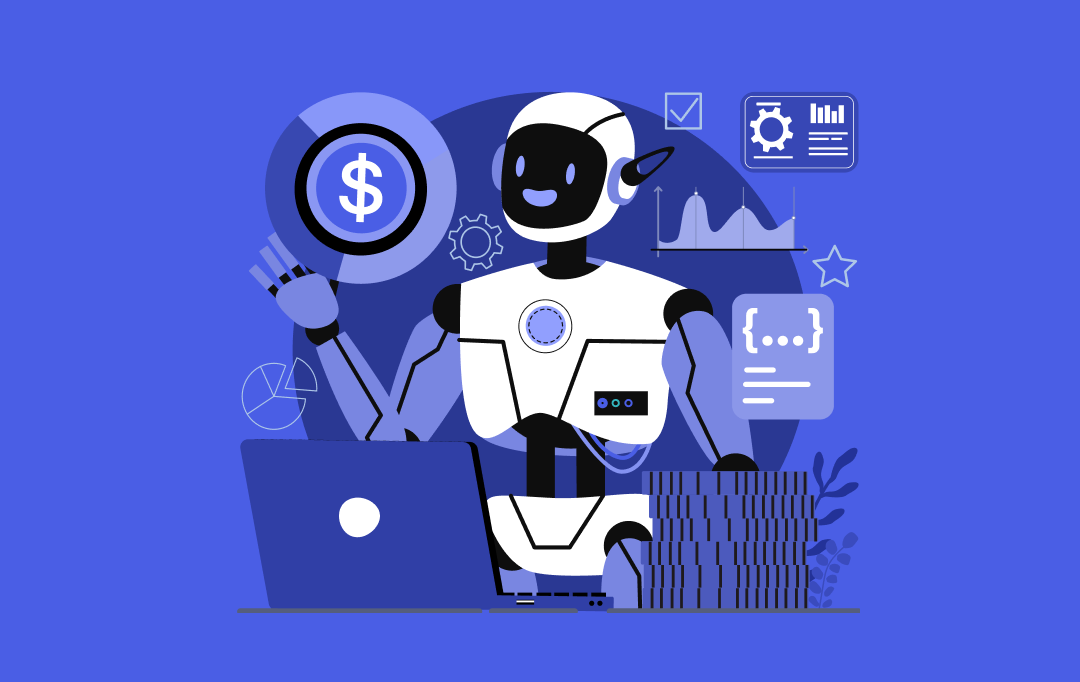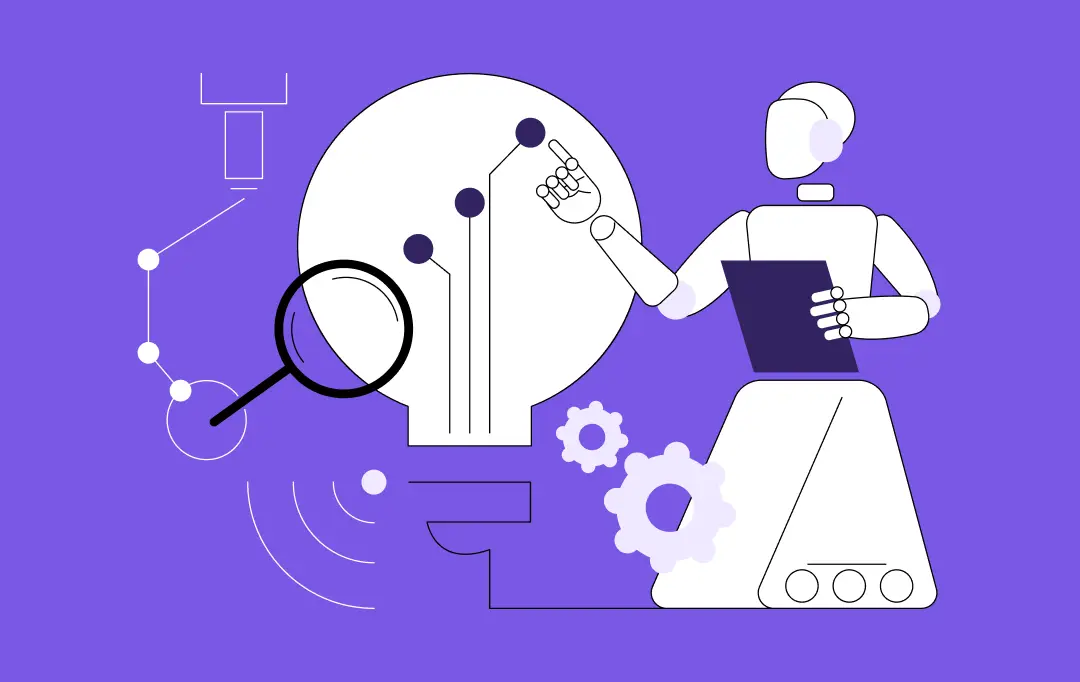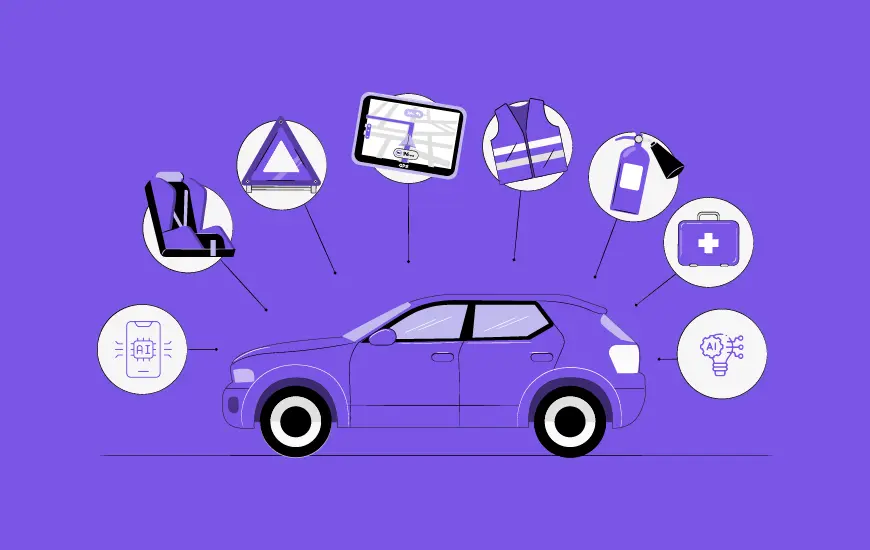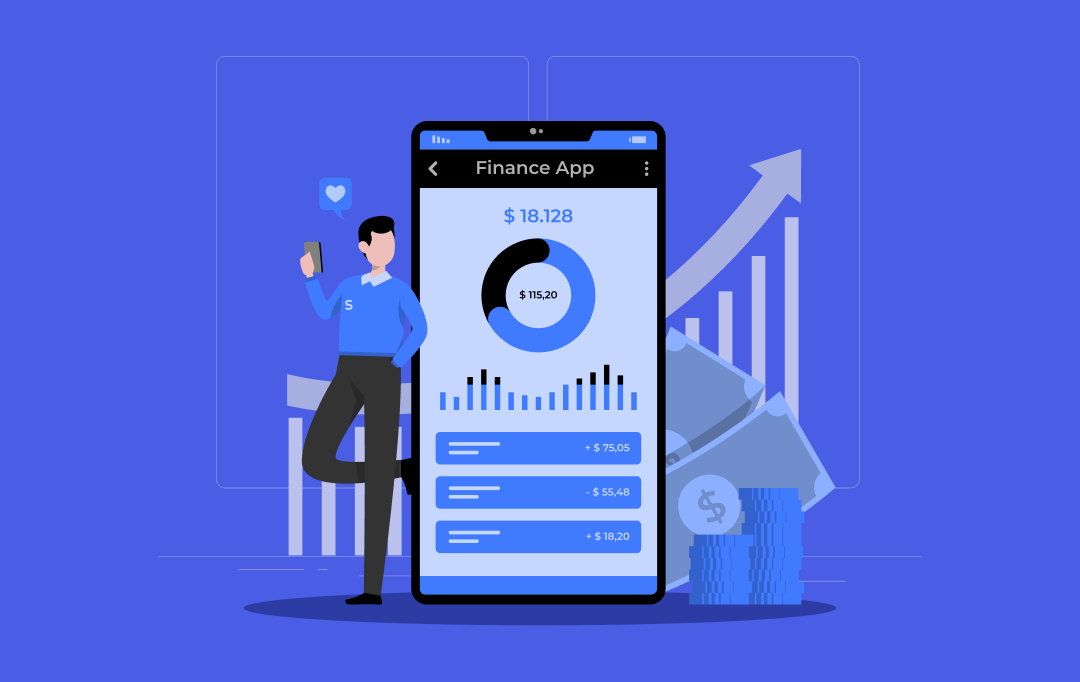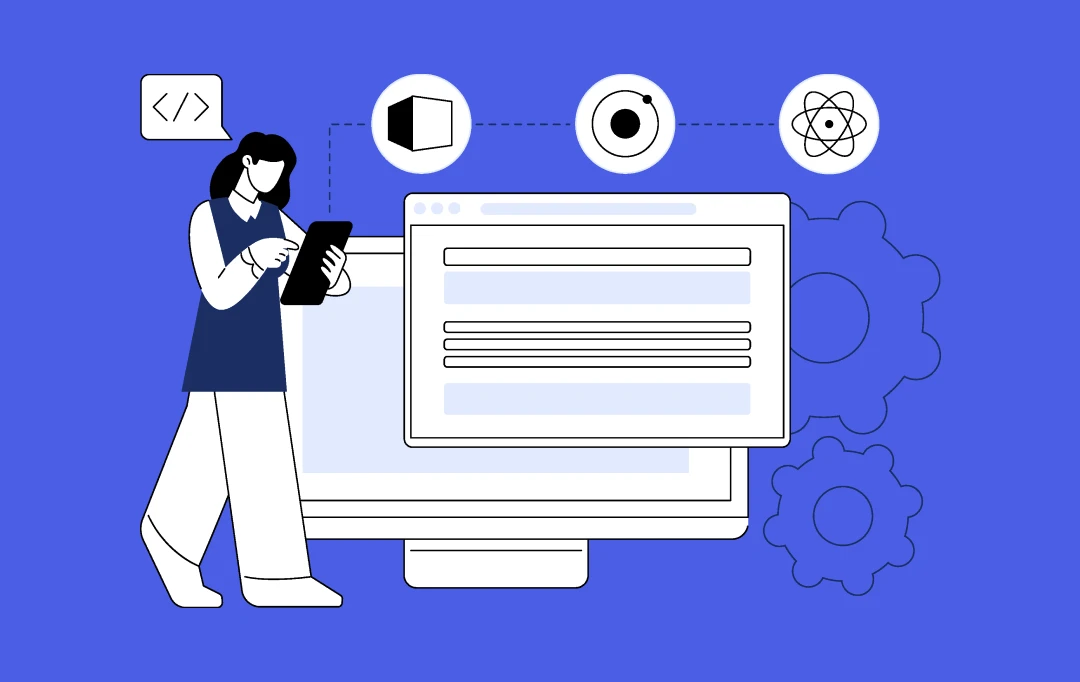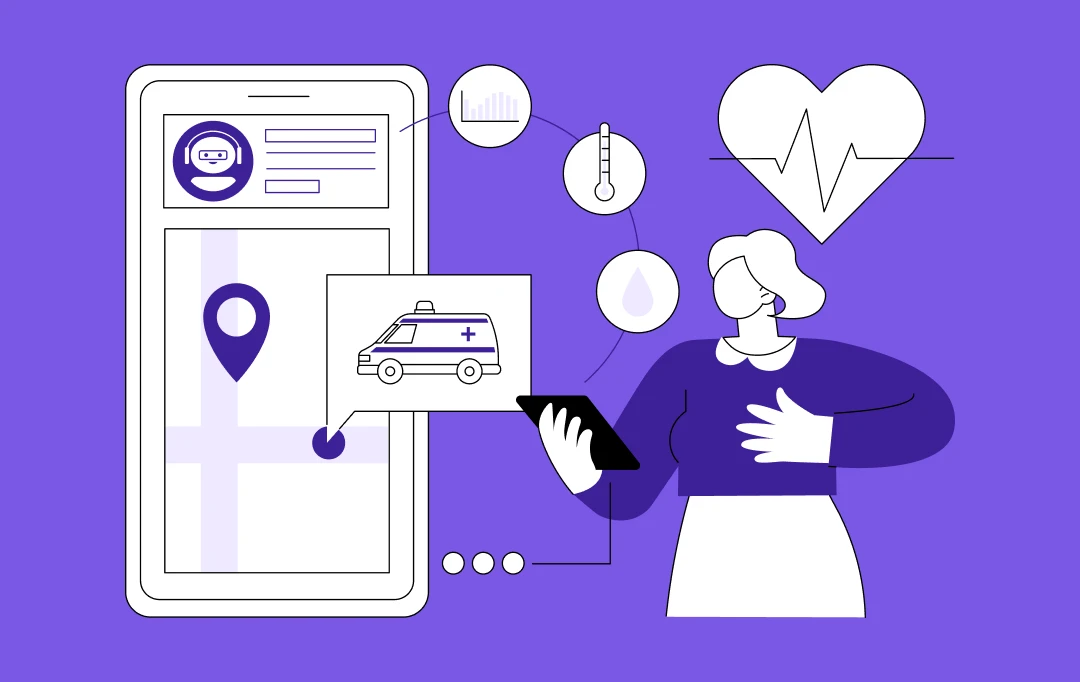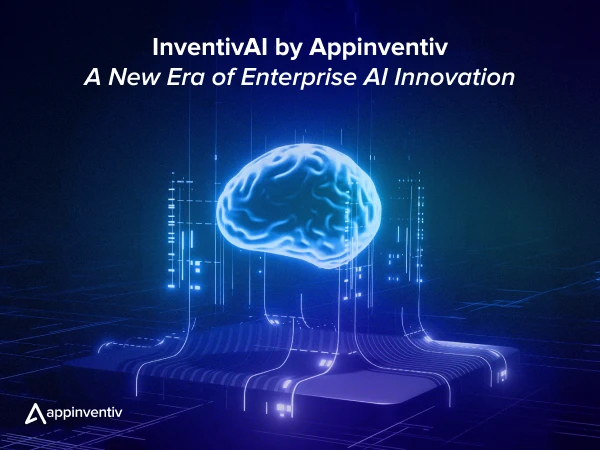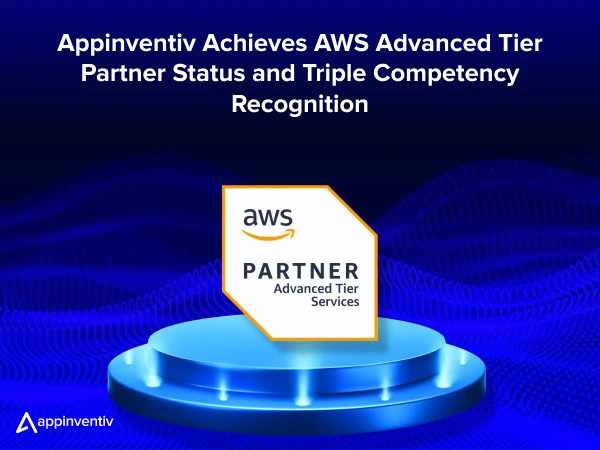- Buy vs Build Software Analysis: Startups and Enterprises
- Prerequisites for Estimating the Software Development Cost
- Project Goals
- Target Audience
- Type of Software
- Understanding the True Cost of Software Development
- Costs Based on Software Complexity
- Breakdown of Costs by Development Stages
- Regional Cost Variations
- Formula for Estimating Software Development Costs
- Time and Effort Estimates
- Software Development Cost Approach: Appinventiv VS. Other Software Development Companies
- Sourcing Models for Software Development Projects
- In-House Development
- Outsourcing
- Staff Augmentation
- Dedicated Development Team
- Factors That Affect Software Development Costs
- Development Team Size (As per Project)
- UI/UX Design of the Software
- Development Team Type
- Post-Maintenance Cost
- Complexity of Features
- Tech Stack
- Third-Party Integrations
- Security Measures
- Compliance Measures
- Platform Selection
- Hidden Software Development Costs You Need to Budget For
- Software Maintenance
- Legal and Licensing Fees
- User Training & Documentation
- Change Requests & Scope Creep
- Outsourcing & Vendor Dependencies
- Practical Approaches to Cut Software Development Costs
- Prioritize Features with MVP Development
- Choose the Right Engagement Model
- Use Open-Source Tools and Frameworks
- Outsource Strategically
- Implement Agile Methodologies
- Avoid Over-Engineering Early On
- Fundamental Steps in the Software Development Process
- Custom Software Development Cost Estimation Techniques
- Empirical Estimation Technique
- Heuristic Estimation Technique
- Analytical Estimation Technique
- Comprehending the Types of Cost Estimates
- Ballpark Estimate
- Budget Estimate
- SoW (Statement of Work)
- How Can Appinventiv Help You with Custom Software Development Cost Estimation?
- FAQs
Want to know how to estimate software development costs in 2025? This blog explores key factors that influence pricing, from project complexity to team structure. Understand how elements like features, integrations, and outsourcing impact overall expenses. Learn how different development approaches, such as in-house, outsourced, or hybrid—affect budgeting. Also, know why accurate cost estimation is crucial for successful project planning and execution.
Technology isn’t just supporting businesses, it’s running them. Whether streamlining operations, elevating customer experiences, or creating entirely new business models, custom software has become the engine of innovation and growth.
It’s no surprise that companies are doubling down: the custom software development services market is growing at a steady 8.9% CAGR and is expected to surpass $283 billion by 2028, according to Gartner.
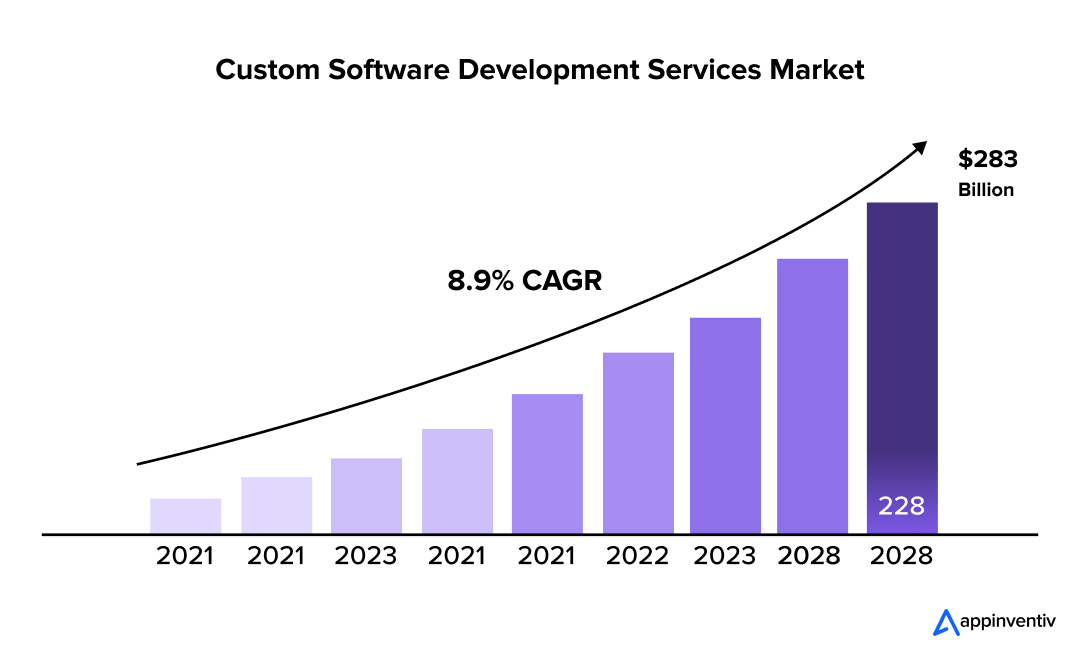
From healthcare and finance to manufacturing and retail, businesses everywhere invest heavily in building solutions tailor-made for their needs because off-the-shelf tools simply can’t keep pace with today’s dynamic demands.
But here’s where many projects stumble: great software doesn’t happen without great planning.
According to a McKinsey report, large IT projects typically exceed their budgets by 45% and run 7% over schedule while delivering 56% less value than initially expected.
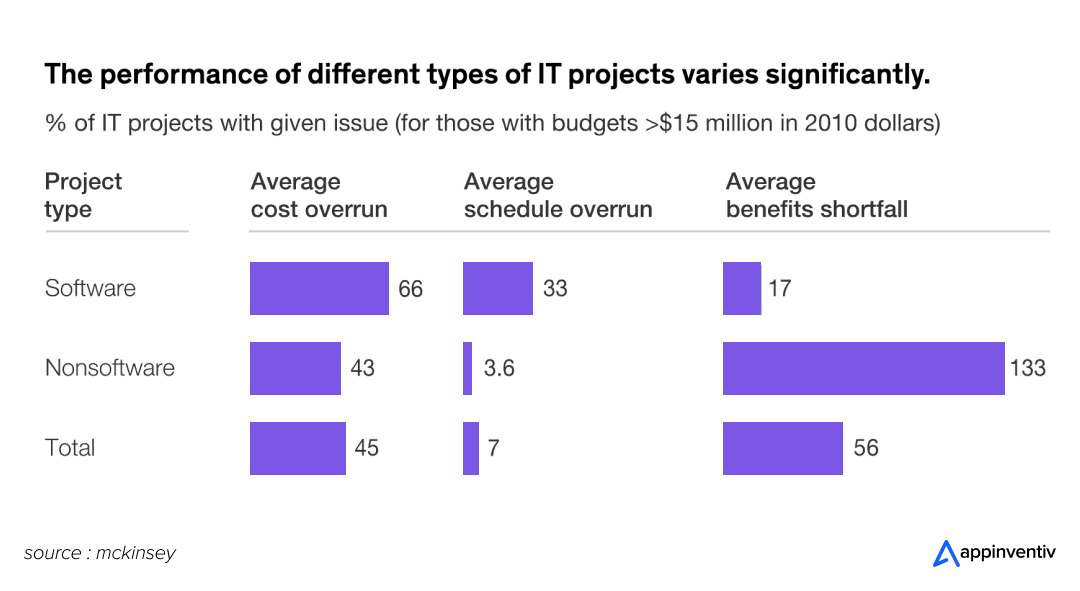
Software initiatives face the highest risk of cost and timeline overruns among all project types. Miss the mark here, and you risk wasting resources, delayed launches, and missed opportunities.
If you want your software investment to deliver real impact, getting the cost estimation right from the start isn’t just smart; it’s critical. Software development costs typically range from $30,000 to $300,000 and sometimes can exceed $1 million. The final investment depends on several key factors: project complexity, required technologies, feature set, team size, development timeline, and industry-specific requirements.
In this guide, we’ll explain how software development costs vary, what factors you need to plan for, and how to set your project up for smooth execution and long-term success.
Be part of the smart majority and start your custom software development process today.
Buy vs Build Software Analysis: Startups and Enterprises
When adopting new software, businesses often face a key decision: build a custom solution from scratch or buy an off-the-shelf product. This choice, commonly known as the “build vs. buy software” dilemma, can significantly impact budget, scalability, and time to market. The right direction largely depends on your organization’s size, goals, and operational complexity.
For many companies, especially when evaluating the cost to build software, the decision must strike a balance between short-term practicality and long-term value. Startups and enterprises approach this question from very different vantage points. Here’s how their priorities shape the decision:
| Aspect | Startups | Enterprises |
|---|---|---|
| Primary Focus | Speed, agility, and cost-efficiency | Flexibility, control, and deep system integration |
| Budget & Resources | Limited funding, small teams | Higher budgets, access to experienced dev teams |
| Preferred Approach | Off-the-shelf tools, plug-and-play platforms | Custom-built solutions tailored to internal needs |
| Time Sensitivity | Urgency to launch quickly and iterate fast | Willing to invest time in robust, scalable solutions |
| Integration Complexity | Low to moderate, often needs minimal integration | High, requires seamless integration with multiple internal systems |
| Scalability Needs | Starts small with flexibility to grow | Needs to support large-scale operations across departments |
Prerequisites for Estimating the Software Development Cost
These prerequisites are discussed with the software development company during the scoping sessions. From explaining your project goals to discussing how you can monetize from software development, a professional organization like Appinventiv will help you every step.
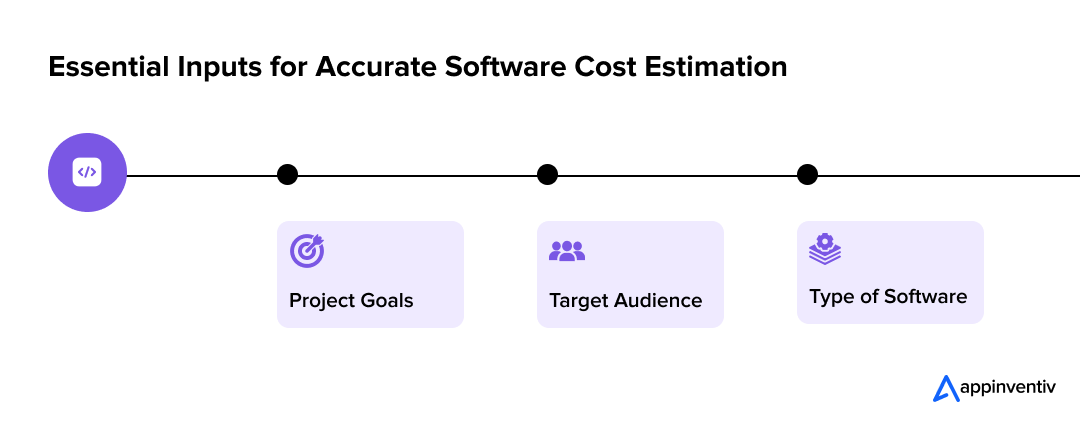
Project Goals
The first step to realizing custom software cost is to explain your project goals during the initial conversation. Highlighting a clear goal can help you design tools for startups worth the effort and cost. While at the same time, discussing the end goals can help the development team stay focused and aligned. Thus, the more well-defined the end goal is, the less time it takes to develop the software and offer better cost optimization.
Target Audience
Determining your target audience is one of the most vital steps for successful software development. The target audience usually includes people interested in your services or products. Conducting an in-depth competition analysis, market research, and identifying the latest trends can help you get a clear idea of your target audience. The total efforts and time taken to determine the target audience will ultimately affect the overall cost of the software.
Type of Software
Finalizing the type of software custom to your requirements is one of the most necessary steps to help you determine the time frame and cost of software development. The more features and complexity of software, the more time and cost are associated with it. A well-integrated software with ample features to engage and retain users will help you progress in the otherwise competitive business landscape.
Understanding the True Cost of Software Development
Understanding software development costs is crucial for businesses investing in custom solutions. The journey from concept to deployment involves various stages, each contributing to the overall pricing.
Let’s break down the key factors influencing these costs and explore how to estimate them accurately.
Costs Based on Software Complexity
The true cost to build software largely depends on the project’s complexity. More intricate software requires more time, effort, and resources, leading to higher costs. Here’s how the cost varies based on complexity:
Basic Software (Low Complexity)
For simpler, basic software with few features, the custom software development cost is lower. This software is often used for small businesses or startups.
Estimated Cost: $30,000 – $50,000
Mid-Level Software (Moderate Complexity)
As the complexity increases, the cost to develop software also rises. This includes custom features, database integration, and a more refined user experience.
Estimated Cost: $50,000 – $120,000
Advanced Software (High Complexity)
The software development cost will be significantly higher for large-scale, enterprise-level software with advanced functionalities like AI and machine learning.
Estimated Cost: $120,000 – $300,000+
Below are a few prominent examples of large-scale development projects undertaken by our team:
We have helped expand KFC’s mobile presence globally by developing end-to-end apps that enabled real-time order tracking and doorstep delivery across seven countries.

Appinventiv has also helped Adidas, one of the largest sports merchandise brands, reach an extensive user base by expanding its web-centric services to mobile through a dedicated application.

Breakdown of Costs by Development Stages
Each phase of the development process contributes to the overall cost of developing software. Here’s how costs are typically distributed across stages:
| Development Stage | Key Activities | Cost Share (%) |
|---|---|---|
| Planning & Analysis | Requirements gathering, project scoping, and initial feasibility studies. | 5–10% |
| Design | UX/UI design, wireframing, prototyping, user flows. | 10–15% |
| Development | Coding, backend work, database setup, and integrations. | 50–60% |
| Testing & QA | Unit testing, bug fixing, and ensuring security. | 15–20% |
| Launch & Deployment | Deployment to production, initial bug fixes, and rollout support. | 5–10% |
| Maintenance | Ongoing support, updates, and feature enhancements. | 10–20% annually |
Regional Cost Variations
The software development cost can fluctuate greatly depending on the region where your development team is located. Here’s how the cost to develop software changes by geography:
| Region | Hourly Rate (Estimated) |
|---|---|
| North America (US, Canada) | $100 – $200/hour |
| Western Europe (UK, Germany, France) | $70 – $150/hour |
| Eastern Europe (Poland, Ukraine, Romania) | $40 – $80/hour |
| Asia (India, Vietnam, Philippines) | $20 – $50/hour |
| Latin America (Brazil, Argentina, Mexico) | $30 – $70/hour |
Formula for Estimating Software Development Costs
The simplest way to software development project cost estimation is by using a straightforward formula. This involves multiplying the number of development hours by the hourly rate.
Total Cost = Hourly Rate × Development Hours
For example, if your project requires 1,000 development hours at a rate of $60/hour:
Estimated Cost = 1,000 × $60 = $60,000
While this offers a general idea, factors such as platform complexity, third-party integrations, advanced features, and post-launch support can significantly impact the final cost. To get a more precise and tailored estimate, businesses are encouraged to use a software development cost calculator, which considers various project-specific variables like technology stack, team size, and timeline requirements.
Time and Effort Estimates
Custom software development costs can differ significantly depending on the project’s scope and complexity. On average, a standard project may take 1 to 6 months and cost between $5,000 and $30,000. This estimate covers a range of solutions, such as SaaS platforms, CRM systems, and web or mobile applications.
However, several factors, such as the level of customization, technology stack, feature requirements, and industry standards, can impact the final price. As a result, budgets can range anywhere from $30,000 to $150,000, with highly complex or enterprise-grade systems reaching or exceeding the $1 million mark.
Here’s an estimate of the time involved based on complexity:
Low-Complexity Software
- Estimated Time: 3 – 6 months
- Effort: Minimal features, simple user interface.
Moderate Complexity Software
- Estimated Time: 6 – 10 months
- Effort: Custom UI/UX, moderate database and system integration.
High-End Software
- Estimated Time: 10 months – 1.5 years
- Effort: Advanced features, AI integration, and large teams.
Key Consideration: More features and higher complexity increase software development costs.
Software Development Cost Approach: Appinventiv VS. Other Software Development Companies
At Appinventiv, we believe in complete visibility throughout your software development journey. We break down every component of your project into clear, understandable elements so you can make informed decisions with confidence. Here’s a table that clarifies how our approach is different from others.
| Cost Factor | Appinventiv’s Approach | Basic Industry Standard |
|---|---|---|
| Development Time | 6-8 weeks | 12-14 weeks |
| Requirement Change Fees | Flexible adjustment protocol | Rigid change order pricing |
| Testing & QA | Comprehensive testing included | Often billed as a separate service |
| Documentation | Complete technical documentation provided | Basic documentation only |
| Third-Party Integration | Fixed price per integration (API and CRM Integrations) | Variable pricing based on complexity |
| Post-Launch Support | Continuous support whenever required | Typically, 30-60 days only |
| Ongoing Maintenance | 15%–20% of the initial development cost per year | Unpredictable hourly billing |
| Infrastructure Setup | Cloud configuration included | Additional setup fees are common |
| Security Implementation | Enterprise-grade security standards included | Basic security only, upgrades cost extra |
| Knowledge Transfer | Complete team training, including brainstorming sessions for detailed project understanding | Limited handover sessions |
Sourcing Models for Software Development Projects
When planning a software development project, it’s essential to choose the right sourcing model to align with your budget, timeline, and quality standards. Here are the main options:
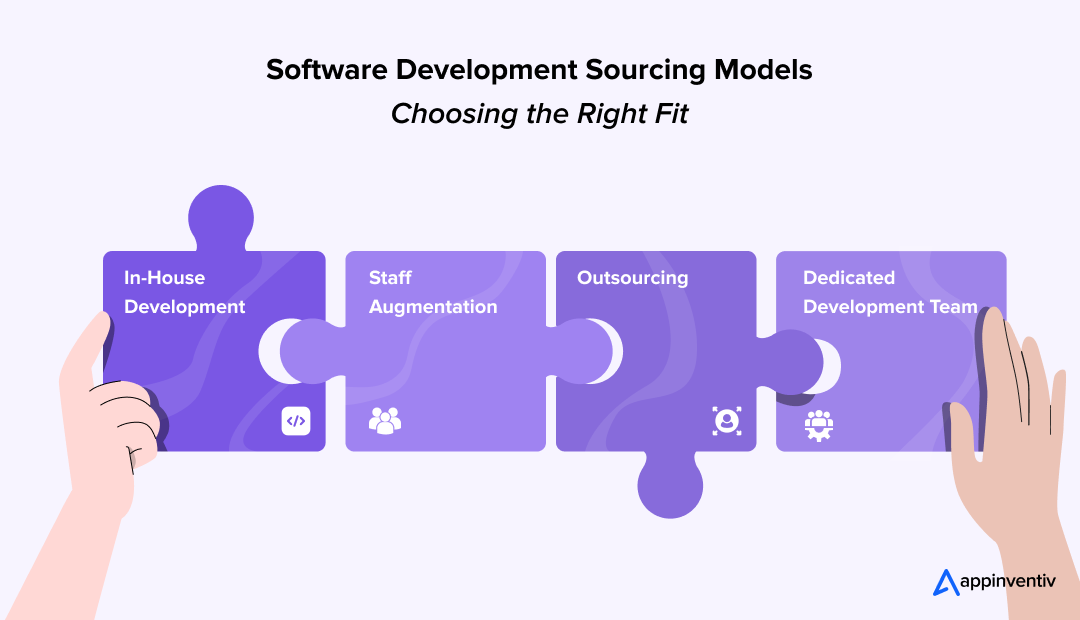
In-House Development
Building an internal team to handle all aspects of software development. This option provides greater control and smoother communication, but can be costly and time-consuming due to the need to hire specialized talent.
Outsourcing
Outsourcing software development involves hiring external companies or freelancers. It can be divided into three categories: offshore development, which uses teams from distant countries to save costs; nearshore development, which involves collaborating with companies in nearby countries to simplify communication; and onshore development, where local firms are employed for better communication and cultural alignment, though it may be more expensive.
Staff Augmentation
Add external experts to your in-house team to fill skill gaps or increase capacity as needed. This model offers flexibility and faster onboarding without long-term hiring commitments. It’s ideal for short-term projects or when specific expertise is temporarily required.
Dedicated Development Team
A dedicated team works exclusively on your project, often provided by a third-party vendor.
You manage the project direction, while the vendor handles staffing, infrastructure, and HR.
It’s a great balance of control, scalability, and long-term collaboration without the overhead of hiring in-house.
Factors That Affect Software Development Costs
If you are wondering how to estimate software development cost, understand that it depends heavily on three significant factors. Let’s take a detailed look at these factors.
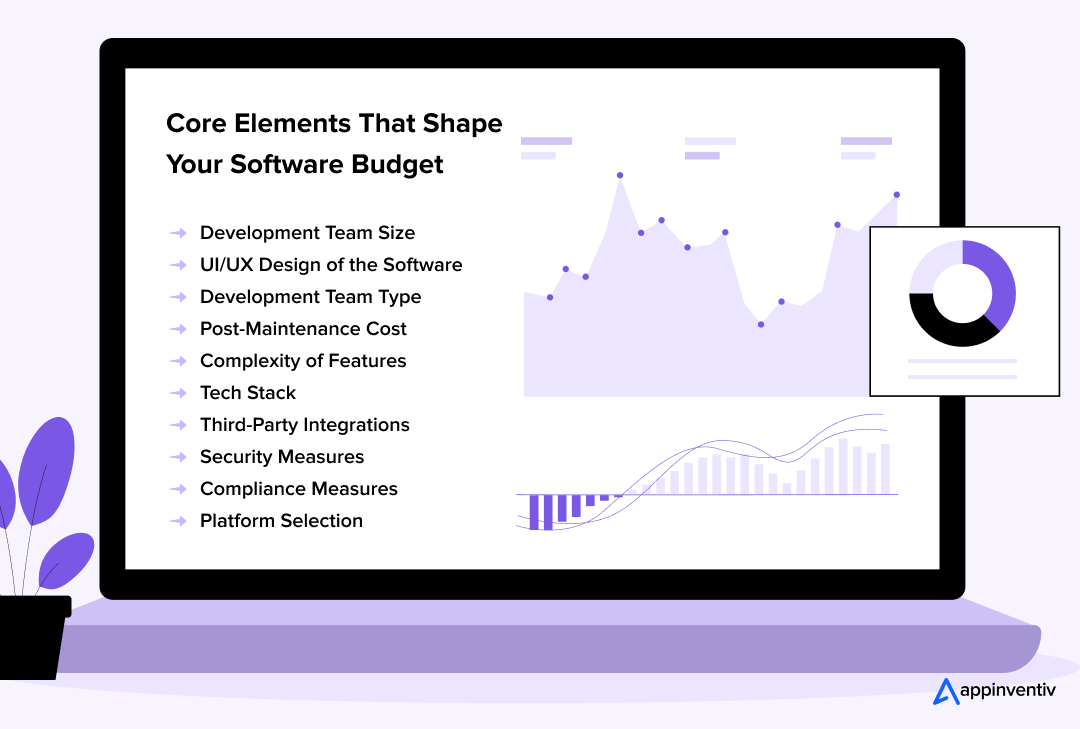
Development Team Size (As per Project)
Once your project is defined in terms of type and size, the only substantial factor that can directly affect your software development cost is your development team size. Your development team requires at least three roles – a developer, a project manager, and a QA tester to perform certain tasks in software development. The hourly rate of developers will also affect the overall cost and will vary according to the geographical location of the software development team.
The cost for software development is heavily influenced by the size and expertise of the development team you choose.
However, the requirements should be well aligned with your project. Below are the roles you can choose from according to your size and type of project:
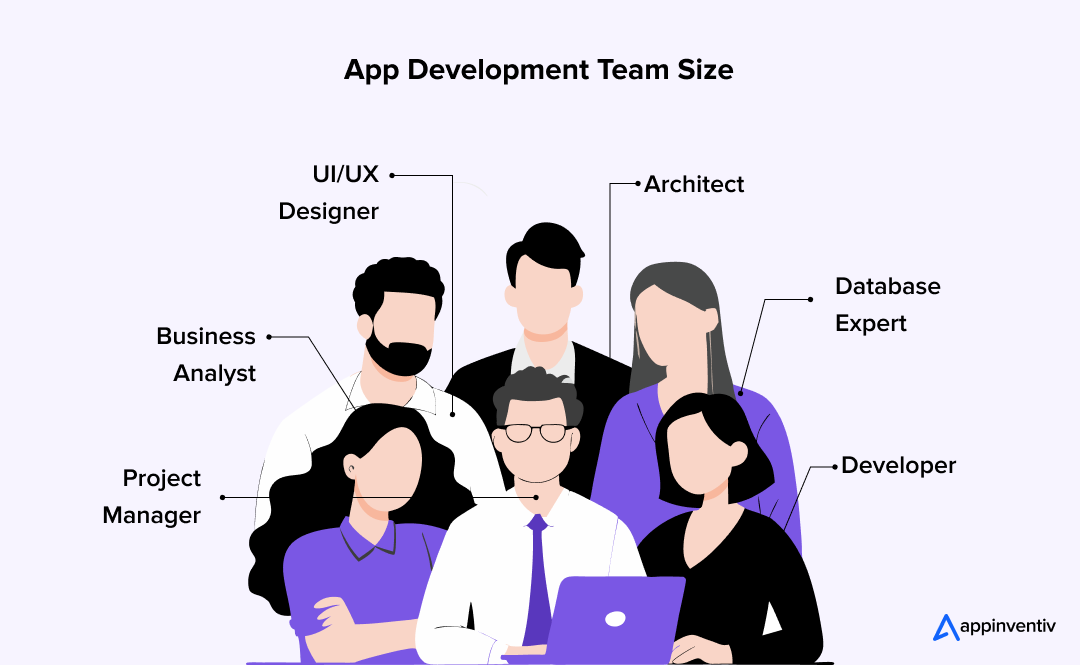
UI/UX Design of the Software
Creating custom software with a clear UI/UX strategy is essential to gaining traction in the market. A seamless software design can improve user engagement and retention. However, meeting clients’ unique needs requires multiple testing procedures, which can affect the cost of building the software from scratch.
Investing in a strong UI/UX foundation also adds to the overall software development price depending on project complexity.
Development Team Type
The type of team you have hired to develop your custom software product also impacts the software’s cost. For instance, you can choose between hiring freelancers, an in-house development team, or simply outsourcing your project to a dedicated software development agency. Different team structures contribute significantly to the software development cost breakdown that businesses must plan for.
Let us look at the pros and cons of all three below:
| Type of Software Development Team | Costing | Quality | Communication | Contact Time Frame |
|---|---|---|---|---|
| In-house team | Highly expensive | High quality product catered by dedicated in-house developers | Easy with the corporate channels | Long-term |
| Outsourced team | Affordable and Optimized | High software product quality considering access to skilled resources and advanced tools | Effective communication with the help of a dedicated project manager | Long-term |
| Freelancer | Most economical | Compromised product quality due to lack of expertise | Poor considering the freelancer is not a part of a dedicated team | Short-term |
Post-Maintenance Cost
Proper maintenance and updates are necessary for the software to facilitate its growth in the digitally evolving ecosystem. Ensuring smooth functioning and optimal software performance across all platforms necessitates taking proactive post-release measures.
The cost of maintaining the software encompasses expenses incurred to ensure a bug-free software experience and investments to provide software upgrades and incorporate new technologies as market demands change. Factoring in post-release support is an important aspect of software development cost estimation to avoid future financial surprises.
Complexity of Features
The features integrated in custom software also impact the overall cost to develop. Software with an extensive feature list will ultimately cost more than one with fewer features.
Furthermore, it is necessary to comprehend that a well-defined feature set for your custom software can distinguish it from the competitors while helping you gain traction in the market. Defining the right features early on can help you stay within your software development budget while maximizing value.
Tech Stack
Advanced technologies such as AI/ML, data analytics, metaverse, and a robust tool set, are necessary for developing a custom software product to set your business apart from the competition.
However, the cost of implementing complex and multiple technologies may vary depending on the hired development team, its location, and more. Choosing an appropriate tech stack plays a major role in managing the cost to build software efficiently without compromising performance.
Third-Party Integrations
In today’s software landscape, integrating third-party services is no longer optional; users expect it. Whether you’re implementing payment gateways like Stripe or PayPal, social logins through Google or Facebook, or location services like Google Maps, each integration demands time for setup, testing, and sometimes recurring licensing fees.
CRM and ERP system integrations can further complicate development. These features contribute significantly to the cost for software development, especially as the number of integrations increases.
Security Measures
Security is a cornerstone of trustworthy software, especially for platforms managing sensitive data like user identities, financial transactions, or medical records. Implementing encryption protocols, secure login systems (OAuth 2.0, JWT), and regular security audits ensures the system remains robust against evolving threats.
Additionally, proactive security investments help maintain compliance with GDPR, HIPAA, and PCI-DSS standards. Incorporating these essential practices will increase the software development price but significantly reduce long-term risks and liabilities.
Compliance Measures
Compliance requirements vary based on industry and region, but ignoring them can result in hefty penalties or delayed product launches. Standards like GDPR for data privacy, HIPAA for healthcare, PCI-DSS for payments, and ADA for accessibility all demand careful planning and implementation.
Meeting these standards typically involves legal consultation, code adjustments, documentation, and ongoing monitoring. These legal and technical requirements are crucial to the software development cost breakdown for regulated industries.
Platform Selection
The platform(s) you choose, whether a web application, a native mobile app for iOS/Android, or a cross-platform hybrid software, directly impact your development scope and cost. For example, native apps require separate builds for each OS, whereas frameworks like Flutter or React Native offer shared codebases.
Choosing between cloud hosting solutions like AWS or Azure versus on-premise servers also affects long-term infrastructure costs. Platform decisions are central to software development cost estimation and should align with your user base and business goals.
Hidden Software Development Costs You Need to Budget For
When planning your software development project, it’s easy to focus only on the initial build cost. However, several hidden expenses can significantly impact your software development budget if not accounted for early on.
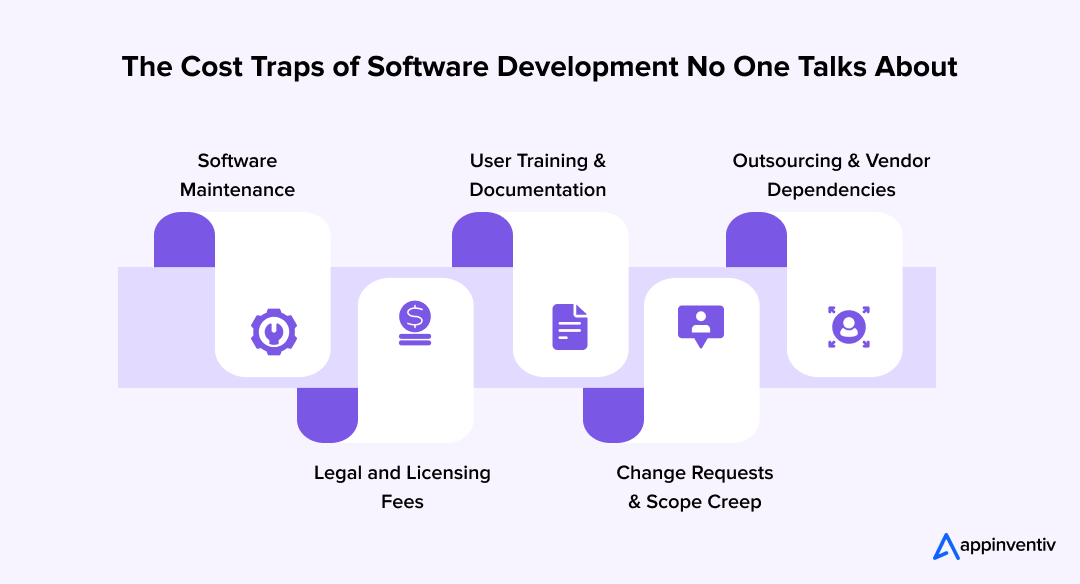
Software Maintenance
After launch, your software will need regular maintenance to fix bugs, ensure compatibility with new systems, apply security patches, and improve performance. Maintenance is an ongoing cost that plays a vital role in sustaining your software’s functionality and user satisfaction, a crucial element in effectively estimating the software development cost.
Legal and Licensing Fees
Using licensed tools, SDKs, APIs, or fonts and images may incur additional fees. Legal costs related to compliance, contracts, and intellectual property protections can also arise. These are often not discussed upfront, but are essential for ensuring your software is legally safe and scalable. These fees frequently contribute to the average cost of software development, especially for enterprise-grade software.
User Training & Documentation
If your software is complex or enterprise-grade, you may need to train users or develop detailed documentation. Whether it’s onboarding internal staff or creating customer manuals, these costs (time, tools, trainers) are often overlooked yet crucial for smooth adoption. Factoring this into the average cost of custom software development ensures you don’t run into post-launch roadblocks.
Change Requests & Scope Creep
As your project evolves, stakeholders may request new features or changes not in the original plan. These changes can drastically increase costs due to rework, new designs, and extended timelines. Implementing a buffer for such cases supports cost optimization in software development without sacrificing quality.
Outsourcing & Vendor Dependencies
If you’re outsourcing parts of the development process (like QA, backend APIs, or UI/UX design), vendor pricing structures, contract extensions, and timezone coordination can introduce additional costs. Being aware of the outsource software development cost helps manage expectations and avoid scope-related surprises.
Practical Approaches to Cut Software Development Costs
Managing a limited budget doesn’t mean you have to sacrifice quality. You can reduce unnecessary expenses and still build a robust, scalable solution with the right strategies. Here are some proven ways to optimize your spending:
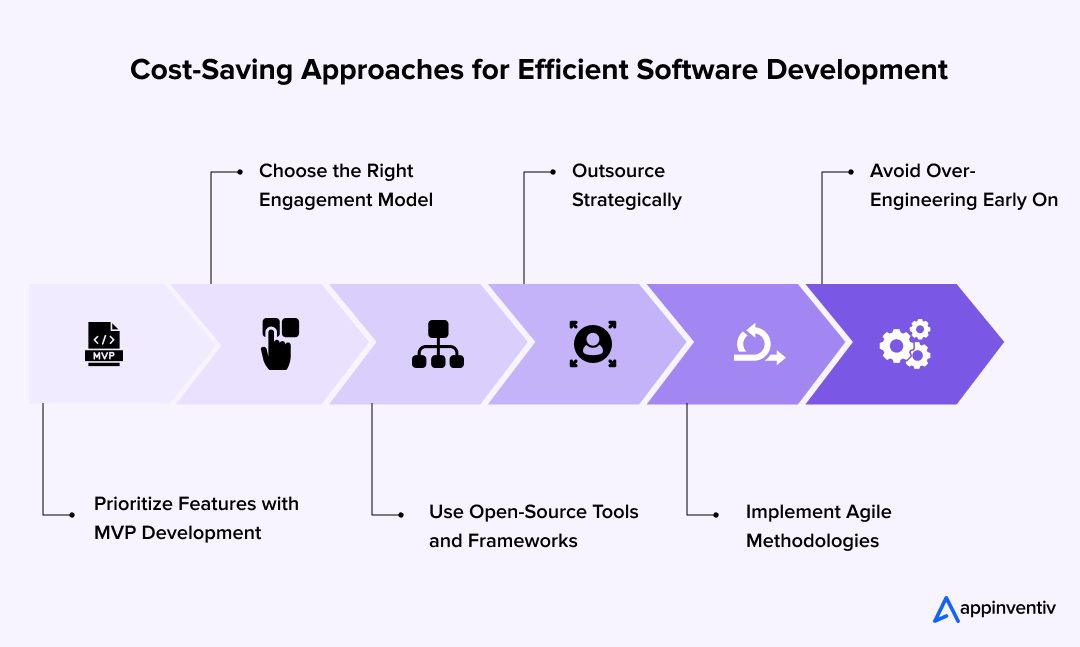
Prioritize Features with MVP Development
Start by building a Minimum Viable Product (MVP) that focuses only on the core features necessary for launch. This approach minimizes initial investment and allows for early market testing before scaling. It’s one of the most effective ways to achieve cost optimization in software development without compromising on product vision.
Choose the Right Engagement Model
Whether you opt for a fixed-price, time & materials, or dedicated team model, selecting the right structure can prevent unnecessary spending and project delays. The engagement model you choose plays a direct role in determining the actual cost to develop software.
Use Open-Source Tools and Frameworks
Leveraging open-source libraries, plugins, and frameworks where applicable can eliminate licensing fees and speed up development time. This strategy can help significantly lower the average cost of custom software development, especially for startups and small businesses.
Outsource Strategically
Partnering with trusted development teams in cost-effective regions is a strategic way to manage your outsourced software development costs. It enables you to access top-tier talent and maintain high-quality standards while keeping your budget in check.
Implement Agile Methodologies
Agile software development encourages iterative releases, ongoing feedback, and adaptability, allowing you to use your time and budget more efficiently. This model ensures optimal resource allocation and helps you manage the cost of software development more efficiently.
Avoid Over-Engineering Early On
Focusing too much on edge cases, scalability, or complex architecture at the start can quickly inflate costs. Build lean and optimize later as you grow. Keeping your initial scope lean helps avoid unnecessary increases in the software development price.
Fundamental Steps in the Software Development Process
Turning a concept into working software is a layered journey; each stage acts as a building block, shaping functionality, user experience, and long-term success. Understanding these core phases sets the foundation for a well-orchestrated development process.
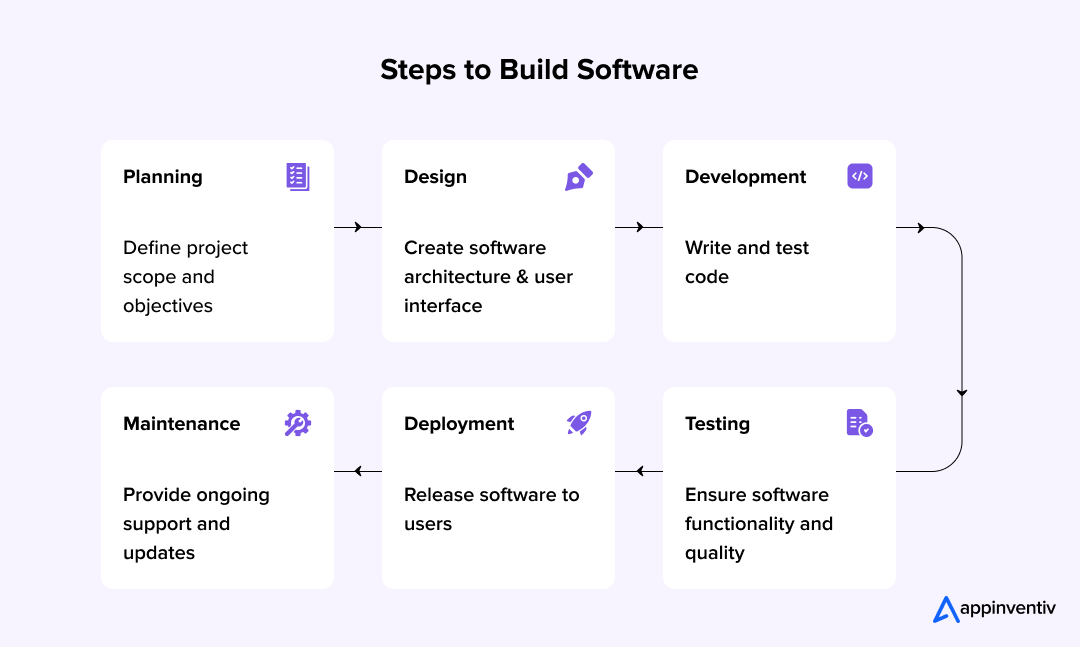
It begins with defining the problem and gathering requirements, then designing a solution that aligns with user needs. Then, the development phase turns these designs into code, while testing ensures everything works as expected, refining the product before launch. Finally, post-launch monitoring and iteration ensure the software continues evolving and improving.
Custom Software Development Cost Estimation Techniques
An accurate software development cost estimation is one of the key parameters that paves the way for a successful project. The techniques listed below will help you understand the complex process of software cost estimation based on the realistic amount of effort, time, and money.
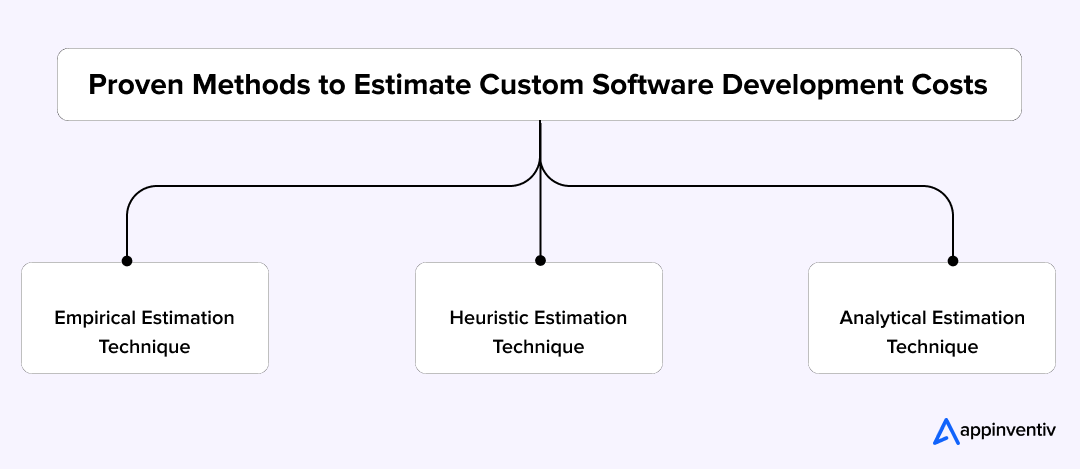
Empirical Estimation Technique
This estimation technique uses assumptions and informed guesswork to leverage data from previously completed projects to provide an initial cost overview. Evidence-based formulas are then applied to refine the estimate. To simplify this process, a software development cost calculator can be used during the planning phase to quickly generate a rough yet reliable cost projection.
Heuristic Estimation Technique
The average cost of software development can also be estimated with the help of the heuristic technique. This approach or software development cost model addresses budget estimation based on multiple angles and is the most viable method to make quick decisions on complex projects. The model offers you a cost estimate by addressing the relationships between multiple elements and parameters of the project.
Analytical Estimation Technique
This software development cost estimation technique is based on dividing the task into multiple operations or elements. After this, each operation’s standard time is applied based on the information gathered from experience.
Now that you understand the multiple software development cost techniques, it is necessary to understand the different types of estimates. These estimates are given to you by the software development company in New York based on your project goals, requirements, and the details discussed during the scoping session.
Comprehending the Types of Cost Estimates
When exploring how much custom software development costs, it’s important to understand the different cost estimates used during various stages of project planning. Each offers a different level of accuracy depending on how clearly the project is defined:
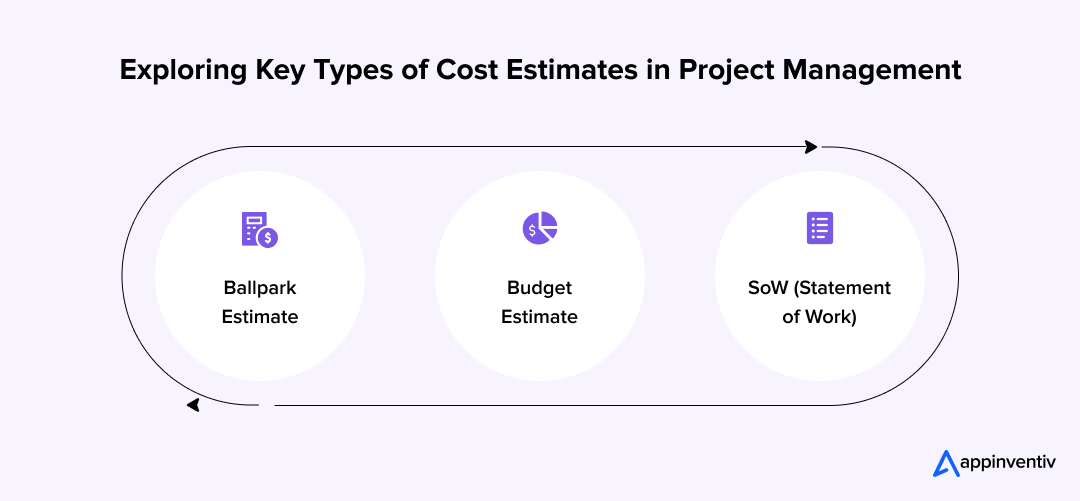
Ballpark Estimate
This kind of estimate will offer you a thumbnail sketch of the estimated cost of software development. This estimate will help you to clearly understand if the software development company can help you pursue development and if you should hire them.
Budget Estimate
A software development budget estimate will offer a forecast to plan the project development strategy. If you can provide a budget for the development organization, this estimate will help you understand whether they can work under the set amount. It is advisable to remember that every project strategy comes with risks associated with time and cost.
SoW (Statement of Work)
This cost estimate defines various project activities, deliverables, and frames. Thus, in writing, you can be upfront with the development company about your needs and strategy and ask them for an accurate cost estimate.
Now that you understand the various software cost estimation techniques, let us discuss estimating the software development time frame, which directly impacts the development cost.
How Can Appinventiv Help You with Custom Software Development Cost Estimation?
At Appinventiv, we don’t just deliver code, we build high-impact digital products that drive business growth and ROI. Backed by over a decade of experience, our software development services are tailored to help startups, enterprises, and Fortune 500 companies streamline their operations, reduce costs, and scale efficiently.
With a presence across the US, Europe, UAE, Qatar, and MENA, we’ve successfully partnered with global brands like IKEA, Domino’s, and JobGet, and international brands. We deliver scalable and secure solutions powered by AI, IoT, cloud, blockchain, and DevOps technologies.
If you’re trying to determine how much custom software development costs, we offer a proven, two-step estimation approach to bring accuracy and transparency to your planning process.
- Rough Estimation: We provide a general estimate to outline the project’s scope and structure in the initial stage. With a 50–75% accuracy range, this step gives clients a starting point to estimate software development cost based on similar project benchmarks.
- Detailed Estimation: For clients ready to proceed, we offer a more accurate and customized software development project cost estimation by:
- Conducting an in-depth consultation to capture project requirements
- Analyzing technical details, feature complexity, and timelines
- Preparing a tailored quote specific to your eCommerce or software goals
- Presenting a proposal with a cost breakdown and strategic insights
Our customized software development services start with an in-depth consultation process and work closely with you to understand your specific requirements and assess the viability of your project. Once the prerequisites are sorted, we move on to the meticulous development of a bespoke and sophisticated software solution that caters to all your business needs.
Connect with us to digitize and upgrade your current business process.
FAQs
Q. How much does it cost to develop software?
A. To understand how much custom software development costs, you first need to determine the type of software you wish to develop. A basic software development pricing can cost can range between $30,000 to $100,000 with a simple feature list, while a highly complex software can cost around $100,000 to $300,000.
Q. How long does it take to develop a software?
A. The time required to build custom software depends on the project’s complexity and requirements. For instance, software with an extensive feature set will take longer to develop compared to software with a minimal feature list.
The development time for complex software can vary between 9 to 12 months, while simple software can be developed in 4 to 5 months. The custom software development process shouldn’t be rushed, as it can lead to a suboptimal final product that lacks sustainability.
Q. How can I accurately estimate the time and cost of custom software development?
A. Follow these expert steps to correctly estimate the :
- Break Down the Work
- Large tasks often hide smaller, time-consuming subtasks.
- Example: “Build front page” → CTA section (4 hrs), Updates (2 hrs), Services (6 hrs), Contact page (5 hrs).
- Ask, Don’t Assume
- Always clarify how your team plans to tackle each task.
- Ask: What’s the process? Any blockers? Do you need more info?
- Communicate Clearly
- Misalignment on scope causes inaccurate estimates.
- Regularly sync with your team to ensure expectations match reality.
- Include Overlooked Essentials
- Don’t skip setup, testing, bug fixes, or deployment in your estimates; they take time and resources.
Q. What should you consider when choosing a software development company for your project?
A. Here’s what you should look for while hiring a software development company:
- Portfolio & Case Studies: Review their portfolio and past projects to assess quality and versatility.
- Industry Experience: Look for proven success in your domain (e.g., eCommerce, healthcare, fintech).
- Tech Expertise: Ensure the team is skilled in relevant technologies and frameworks.
- Communication & Transparency: Choose a team that offers regular updates and open collaboration.
- Client Reviews & Ratings: Check third-party platforms for verified feedback.
- Development Approach: Agile, flexible processes ensure timely delivery and adaptability.
- Scalability & Support: Opt for a partner that can scale with your growth and offer post-launch support.


- In just 2 mins you will get a response
- Your idea is 100% protected by our Non Disclosure Agreement.
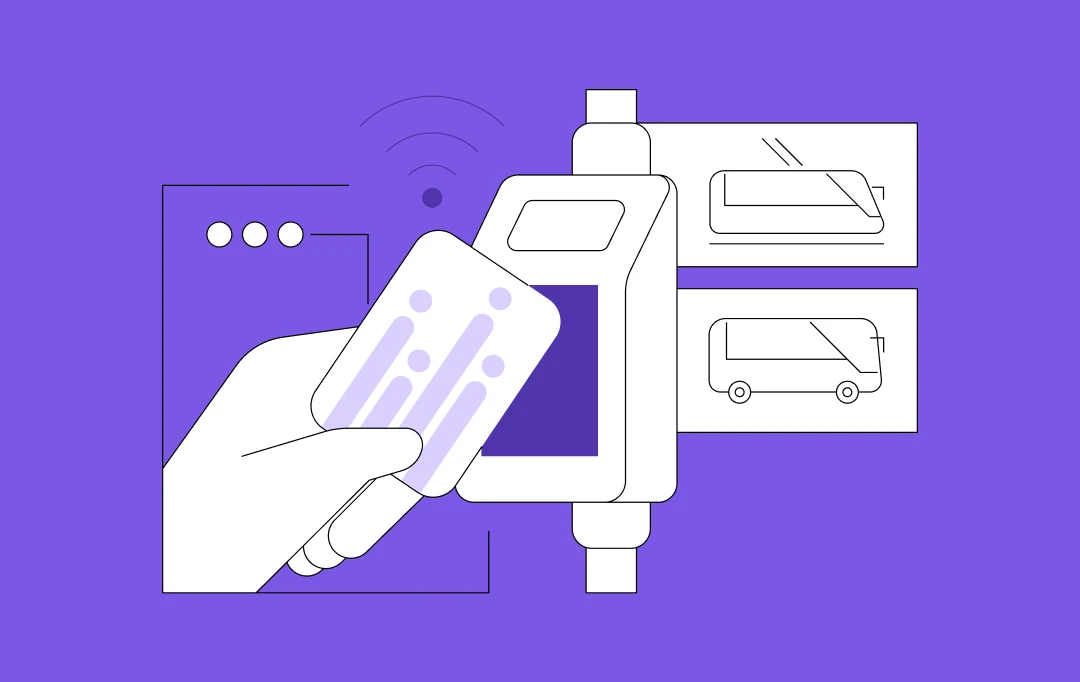
How to Build an RFID Asset Tracking System in The UAE?
Key takeaways: The success of an RFID asset tracking system is dictated by the quality of the custom software and middleware, which must transform voluminous raw tag data into actionable intelligence. Implementation of RFID systems requires a managed, multi-stage process, moving logically from Integration Consulting and architectural design to Continuous Monitoring and Optimization, which is…

How to Build a White-Label Grievance Management Software? Process, features, costs
Key Takeaways White-label grievance management software allows businesses to quickly implement, rebrand, and scale solutions without reinventing the wheel. The development process involves multiple stages, including requirement gathering, workflow design, tech stack selection, and ensuring compliance and scalability. Key features include multi-channel intake, automated routing, customizable workflows, AI-driven categorization, and built-in compliance and security. Costs…
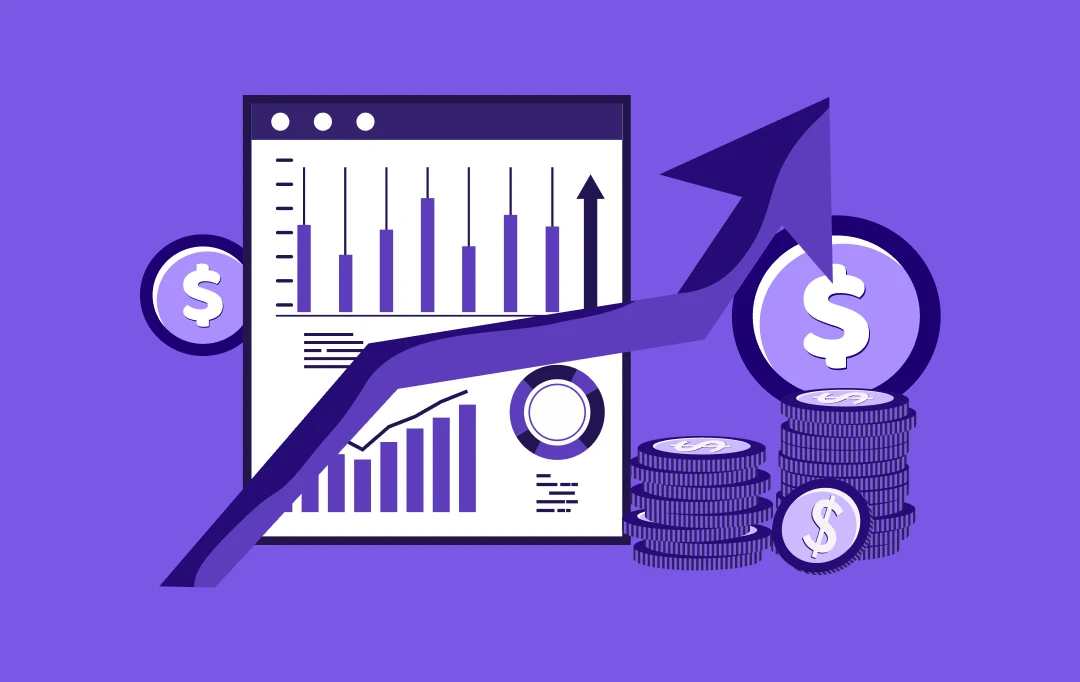
How to Build a Demand Forecasting Software?
Key Takeaways Modern demand forecasting software leverages AI and real-time data to boost accuracy and efficiency. Custom solutions integrate seamlessly with ERP, CRM, and inventory systems for end-to-end visibility. Accurate forecasting reduces costs, optimizes resources, and improves customer satisfaction. Cloud-based, scalable platforms make advanced demand planning accessible to businesses of any size. Demand forecasting used…
